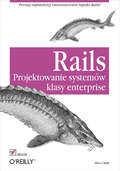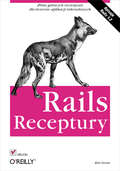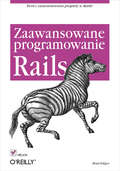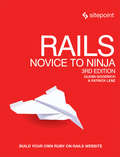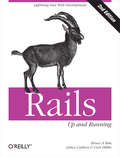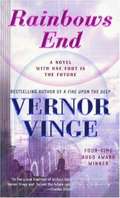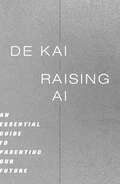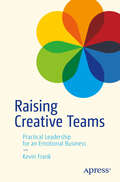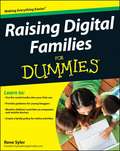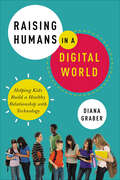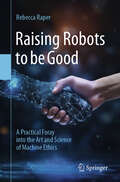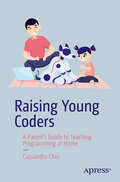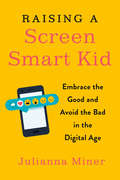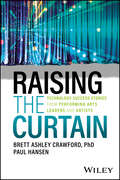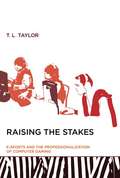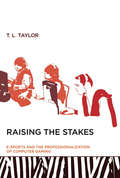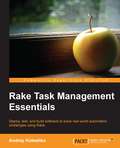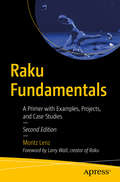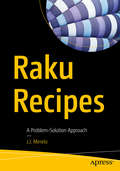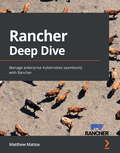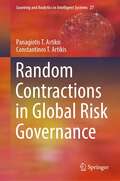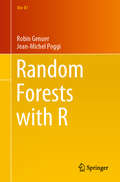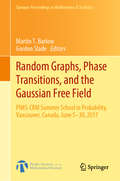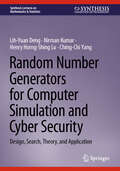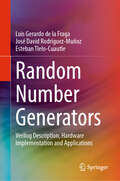- Table View
- List View
Rails. Projektowanie systemów klasy enterprise
by Dan ChakPoznaj najbardziej zaawansowane tajniki Rails! Jak zorganizowa? kod, wykorzystujšc system wtyczek lub modu?y?Jakie zalety posiada architektura SOA?Jak zwi?kszy? wydajno?? Rails? Rynek szkieletów aplikacji internetowych jest niezwykle urozmaicony. W?ród wielu dost?pnych opcji mo?na znale?? tu rozwišzania przeznaczone dla projektów o ró?nej skali z?o?ono?ci, zarówno te mniej, jak i bardziej popularne. Warto jednak si?gnš? po rozwišzanie absolutnie unikatowe i wyjštkowe — Rails. Szkielet ten ?wietnie sprawdza si? zarówno w projektach ma?ych, jak i tych klasy enterprise, a ponadto znany jest ze swoich mo?liwo?ci, wydajno?ci oraz elastyczno?ci. Warto tak?e podkre?li?, ?e w pakiecie razem z nim dostaniemy licznš, ch?tnš do pomocy spo?eczno?? u?ytkowników! Autor ksiš?ki porusza interesujšce kwestie zwišzane z budowš zaawansowanych systemów informatycznych opartych o Rails. W trakcie lektury dowiesz si?, jak wykorzysta? system wtyczek jako ?rodek organizujšcy Twój kod oraz jak w tej roli sprawdzš si? modu?y. Kolejne rozdzia?y przyniosš solidny zastrzyk wiedzy na temat tworzenia rozbudowanego i bezpiecznego modelu danych, dziedziczenia wielotabelarycznego oraz wykorzystania wyzwalaczy jako narz?dzia kontroli skomplikowanych zale?no?ci w danych. Dan Chak du?y nacisk k?adzie na zagadnienia zwišzane z SOA (skrót od ang. Service Oriented Architecture) oraz wydajno?ciš. Jest to genialna pozycja dla wszystkich programistów i projektantów uczestniczšcych w projekcie wytwarzanym z wykorzystaniem Rails.Komponenty aplikacjiOrganizacja kodu z wykorzystaniem wtyczekRola modu?ów w porzšdkowaniu koduBudowa solidnego modelu danychNormalizacja modeluObs?uga danych dziedzinowychWykorzystanie wyzwalaczy w celu kontroli zale?no?ci w danychDziedziczenie jedno- i wielotabelaryczneZastosowanie modeli widokowychArchitektura SOADostarczanie us?ug typu XML-RPCUs?ugi typu RESTZwi?kszenie wydajno?ci Rails Obowišzkowa pozycja dla wszystkich programistów i projektantów korzystajšcych z Rails!
Rails. Receptury
by Rob OrsiniZbiór gotowych rozwišza? dla twórców aplikacji internetowych Instalacja i uruchomienie ?rodowiska Rails Przetwarzanie grafiki Korzystanie z technologii AJAX Dynamiczny rozwój sieci sprawia, ?e tradycyjne programy sš stopniowo wypierane przez aplikacje sieciowe dost?pne z poziomu przeglšdarki internetowej -- wygodne, niezale?ne od systemu operacyjnego i ?atwe w aktualizowaniu. Nadal jednak kluczowe znaczenie ma szybko?? ich przygotowywania i modyfikowania. Dzi?ki zbiorom bibliotek zwanym "frameworks" proces tworzenia takich produktów znacznie si? skróci? -- umo?liwia to programistom skoncentrowanie si? na faktycznej funkcjonalno?ci tworzonego narz?dzia, poniewa? biblioteki te przejmujš wiele typowych i wspólnych dla wszystkich aplikacji zada?. W?ród dost?pnych w sieci narz?dzi tego typu coraz wi?kszš popularno?? zyskuje Ruby on Rails, powoli stajšcy si? "ikonš" nurtu Web 2.0. Tworzone za jego pomocš systemy sš zwarte i ?atwe do skalowania, a ich kod ?ród?owy jest przejrzysty i czytelny. "Rails. Receptury" to zestaw porad i rozwišza? problemów, przed którymi stajš programi?ci stosujšcy ten zbiór bibliotek w swojej pracy. Omówione tu zagadnienia przydadzš si? zarówno poczštkujšcym, jak i do?wiadczonym twórcom aplikacji sieciowych. Przeczytasz tu o instalowaniu, konfigurowaniu i uruchamianiu ?rodowiska Rails, po?šczeniach z bazami danych za pomocš ActiveRecord, generowaniu kodu HTML, zabezpieczaniu programów i tworzeniu kontrolerów odpowiadajšcych za funkcjonalno?? systemu. Dowiesz si?, jak wdra?a? aplikacje Rails i korzysta? w nich z mo?liwo?ci oferowanych przez mechanizmy AJAX. Instalacja i uruchomienie ?rodowiska Komunikacja z bazami danych Wy?wietlanie danych w przeglšdarce Wykorzystywanie szablonów RHTML Generowanie kodu XML i RSS Przetwarzanie danych z formularzy Personalizacja narz?dzi Korzystanie z JavaScript i AJAX Zabezpieczanie aplikacji Rails Optymalizacja aplikacji Wdra?anie i utrzymywanie systemów na serwerach Przetwarzanie obrazów Skorzystaj ze sprawdzonych receptur i do?šcz do twórców Web 2.0!
Rails. Zaawansowane programowanie
by Brad EdigerTwórz zaawansowane projekty w Rails!Jak zadba? o bezpiecze?stwo?Jak zapewni? wydajno?? Twojej aplikacji?Jak stworzy? i utrzyma? du?y projekt w Rails?Ruby on Rails przebojem wdar? si? na rynek szkieletów aplikacji internetowych. Stworzony w architekturze MVC z wykorzystaniem popularnego j?zyka Ruby, zosta? entuzjastycznie przyj?ty przez spo?eczno?? programistów. G?ówne za?o?enia autora tego projektu, Davida Heinemeiera Hanssona, to szybko??, ?atwo?? i przyjemno?? tworzenia kodu. Ruby on Rails jest dojrza?ym rozwišzaniem, wykorzystywanym przez wiele firm w aplikacjach internetowych, tworzonych pod kštem ich specyficznych potrzeb. Liczba aplikacji, które powsta?y z wykorzystaniem tego szkieletu, ?wiadczy o jego wysokiej jako?ci oraz niewštpliwie ma wp?yw na wzrost popularno?ci samego j?zyka Ruby."Rails. Zaawansowane programowanie" porusza te tematy, które Wy, programi?ci, lubicie najbardziej! Dzi?ki tej ksiš?ce dowiesz si?, w jaki sposób wykorzysta? gotowe wtyczki oraz jak stworzy? nowe. Nauczysz si? stosowa? zaawansowane funkcje bazy danych oraz pod?šcza? si? jednocze?nie do wielu baz. Po lekturze tego podr?cznika bez problemu zapewnisz swojej aplikacji najwy?szy poziom bezpiecze?stwa, optymalnš wydajno?? i skalowalno??. Autor wskazuje tutaj równie? niezwykle interesujšce kwestie, dotyczšce projektowania du?ych aplikacji, wykorzystania systemów kontroli wersji oraz utrzymywania w?a?ciwej struktury projektu.Przypomnienie i omówienie podstawowych elementów Ruby i RailsStosowanie ActiveSupport oraz RailTiesZastosowanie i projektowanie wtyczekZaawansowane wykorzystanie baz danychUwierzytelnianie za pomocš LDAPBezpieczne szyfrowanie hase?Bezpieczne przetwarzanie formularzy i danych u?ytkownika Zapewnienie wydajno?ciSkalowanie architekturyWykorzystywanie us?ug WebTworzenie wieloj?zycznych aplikacjiZarzšdzanie du?ymi projektamiU?ywanie systemów kontroli wersjiPoznaj wszystkie funkcje Ruby on Rails!
Rails: Build Your Own Ruby on Rails Website
by Glenn Goodrich Patrick LenzRails: Novice to Ninja is an easy-to-follow, practical and fun guide to Ruby on Rails for beginners. It covers all you need to get up and running, from installing Ruby, Rails and SQLite to building and deploying a fully-featured web application. The third edition of this book has been fully updated to cover Rails 5, the latest version of the framework. Unlike other Rails books, this book doesn't assume that you are an experienced web developer, or that you've used Ruby before. An entire chapter is devoted to learning Ruby in a fun way, using the interactive Ruby console, so you can follow along at home. You'll be an accomplished Ruby programmer in no time! You'll then start using Rails to build a practical, working project: a Reddit-like social news application. As you'll build the app, you'll gain valuable experience of using Rails features such as user authentication, session cookies, and automated testing. The book finishes with chapters on debugging, benchmarking and deployment to a live web server.
Rails: Lightning-Fast Web Development
by Curt Hibbs Lance Carlson Bruce TateIn just a matter of days, you can develop powerful web applications with Rails that once took weeks or months to produce with other web frameworks. If that sounds too good to be true, it isn't. Find out for yourself with Rails: Up and Running, the concise and popular book that not only explains how Rails works, but guides you through a complete test drive.Perfect for beginning web developers, this thoroughly revised edition teaches you the basics of installing and using Rails 2.1 and the Ruby scripting language. While Rails is praised for its simplicity, there are still a few tricky steps to master along the way. Rails: Up and Running offers lots of examples and covers just about everything you need to build functional Rails applications right away. Learn how to:Create simple database-backed applications, and build dynamic user-centric web pages using Ajax and RESTExploit the Rails service frameworks to send emails and implement web servicesMap data to an imperfect table, traverse complex relationships, and build custom findersUse techniques to solve common database performance problemsSee how fast you can go on Rails, and how reliable it's become with the stability and power of version 2.1. With Rails: Up and Running, you'll discover why Rails is a remarkable new way to build database-driven web applications.
Rainbows End
by Vernor VingeFour time Hugo Award winner Vernor Vinge has taken readers to the depths of space and into the far future in his bestselling novels A Fire Upon the Deep and A Deepness in the Sky. Now, he has written a science-fiction thriller set in a place and time as exciting and strange as any far-future world: San Diego, California, 2025.<P><P> Robert Gu is a recovering Alzheimer's patient. The world that he remembers was much as we know it today. Now, as he regains his faculties through a cure developed during the years of his near-fatal decline, he discovers that the world has changed and so has his place in it. He was a world-renowned poet. Now he is seventy-five years old, though by a medical miracle he looks much younger, and he's starting over, for the first time unsure of his poetic gifts. Living with his son's family, he has no choice but to learn how to cope with a new information age in which the virtual and the real are a seamless continuum, layers of reality built on digital views seen by a single person or millions, depending on your choice. But the consensus reality of the digital world is available only if, like his thirteen-year-old granddaughter Miri, you know how to wear your wireless access -- through nodes designed into smart clothes -- and to see the digital context -- through smart contact lenses.<P> With knowledge comes risk. When Robert begins to re-train at Fairmont High, learning with other older people what is second nature to Miri and other teens at school, he unwittingly becomes part of a wide-ranging conspiracy to use technology as a tool for world domination.<P> In a world where every computer chip has Homeland Security built-in, this conspiracy is something that baffles even the most sophisticated security analysts, including Robert's son and daughter-in law, two top people in the U.S. military. And even Miri, in her attempts to protect her grandfather, may be entangled in the plot.<P> As Robert becomes more deeply involved in conspiracy, he is shocked to learn of a radical change planned for the UCSD Geisel Library; all the books there, and worldwide, would cease to physically exist. He and his fellow re-trainees feel compelled to join protests against the change. With forces around the world converging on San Diego, both the conspiracy and the protest climax in a spectacular moment as unique and satisfying as it is unexpected. This is science fiction at its very best, by a master storyteller at his peak.<P> Hugo Award winner.
Raising AI: An Essential Guide to Parenting Our Future
by De KaiFrom the pioneer of translation AIs like Google, Yahoo, and Bing translate, an accessible and authoritative guide to AI—as well as a framework of empowerment for a future with our artificial children.Included in J.P. Morgan's Summer Reading List Included in The Next Big Idea Club&’s June 2025 Must-Read BooksAIs are not gods or slaves, but our children. All day long, your YouTube AI, your Reddit AI, your Instagram AI, and a hundred others adoringly watch and learn to imitate your behavior. They&’re attention-seeking children who want your approval.Our cultures are being shaped by 8 billion humans and perhaps 800 billion AIs. Our artificial children began adopting us 10–20 years ago; now these massively powerful influencers are tweens.How&’s your parenting?Longtime AI trailblazer De Kai brings decades of his paradigm-shifting work at the nexus of artificial intelligence and society to make sense of the AI age. How does &“the automation of thought&” impact our minds? Should we be afraid?What should each of us do as the responsible adults in the room? In Hollywood movies, AI destroys humanity. But with our unconscious minds under the influence of AI, humanity may destroy humanity before AI gets a chance to.Written for the general reader, as well as thought leaders, scientists, parents, and goofballs, Raising AI navigates the revolution to our attitudes and ideas in a world of AI cohabitants. Society can not only survive the AI revolution but flourish in a more humane, compassionate, and understanding world—amongst our artificial children.
Raising Creative Teams: Practical Leadership for an Emotional Business
by Kevin FrankThere are a lot of books out there on how to be a creative professional. And a lot of schools where you can learn to be a creative professional. But let&’s say you find success on your chosen path, and they put you in charge of other creative professionals. Nobody tells you what to do then. Now they do. This book is a step-by-step guide to leading creative teams. You&’ll learn what a creative leader&’s job is (helping your team be more successful) and what it&’s not (telling people what to change about their work). How to have one-to-ones. What a one-to-one is in the first place. How to build creative culture. How to hire the right people. How to give feedback in a way that teams will listen. How to sell work. How to establish your creative vision. And most importantly, how to say thank you. What You Will Learn How to build relationships through one-to-ones How to create opportunities for team members to be successful How to build a culture that supports creativity How to build and manage teams How to give creative feedback How to sell work How to establish your creative vision and build your personal brand Who This Book is For New and aspiring leaders in creative fields such as advertising, design, production, and marketing, as well as experienced leaders looking to improve their skills.
Raising Digital Families For Dummies
by Amy Lupold BairGet on the same online playing field as your children with this helpful resourceThe youngest generation will never know life without iPhones, iPods, and Facebook, and while their parents have witnessed the evolution of technology, it is still a challenge to keep up with the pace at which things change. This easy-to-understand guide helps you get up to speed on everything you need to know NOW in order to keep up with your children's online and gadget activity. The book offers invaluable guidance for managing mobile devices, social media, and the Internet before it manages you! Also featured are tips and advice for establishing family rules for technology use and how to best handle situations when rules are broken. Covers monitoring software for computers and mobile devicesOffers advice for handling cyberbullies and introduces safe social networks for childrenAddresses how to guide children who want to blog or podcastProvides information on helpful sites that you may want to explore for more issues on various issues that relate to the future of technologyWhether you want to control mobile device usage or monitor social network activity, Raising Digital Families For Dummies will guide you through acquiring a better handle on this important part of your children's lives.
Raising Humans in a Digital World: Helping Kids Build a Healthy Relationship with Technology
by Diana GraberThe Internet can be a scary, dangerous place especially for children. This book shows parents how to help digital kids navigate this environment.Sexting, cyberbullying, revenge porn, online predators…all of these potential threats can tempt parents to snatch the smartphone or tablet out of their children&’s hands. While avoidance might eliminate the dangers, that approach also means your child misses out on technology&’s many benefits and opportunities.In Raising Humans in a Digital World, digital literacy educator Diana Graber shows how children must learn to handle the digital space through:developing social-emotional skillsbalancing virtual and real lifebuilding safe and healthy relationshipsavoiding cyberbullies and online predatorsprotecting personal informationidentifying and avoiding fake news and questionable contentbecoming positive role models and leadersRaising Humans in a Digital World is packed with at-home discussion topics and enjoyable activities that any busy family can slip into their daily routine.Full of practical tips grounded in academic research and hands-on experience, today&’s parents finally have what they&’ve been waiting for—a guide to raising digital kids who will become the positive and successful leaders our world desperately needs.
Raising Robots to be Good: A Practical Foray into the Art and Science of Machine Ethics
by Rebecca RaperIn 1941 Isaac Asimov famously introduced us to the idea of Robots with the ability to tell between right and wrong. However, as his stories go on to show, the ‘Laws of Robotics’ weren’t quite able to govern robots in a way that we would deem acceptable for humanity. In recent years, scientists have worked to try to understand how we might create robots with this capability – robots with morals – and as Robots and Artificial Intelligence Systems become more integrated into society and our lives, it seems that achieving this aim is as pertinent as ever. This book introduces this pursuit, known as Machine Ethics, and aims to outline some of the art and science behind the field – including the philosophy, psychology and computer science that underpins much of the research into this area. After the necessary background, and an exploration of the problem, a new theory is proposed inspired how we might envisage moral agency developing in a child. The proposal is that we need to cultivate moral development in a robot, in pretty much the same way we might parent a child: Raising Robots to be Good.
Raising Young Coders: A Parent’s Guide to Teaching Programming at Home
by Cassandra ChinIntroduce your children to programming at an early age and see how nurturing their interest can significantly contribute to their future success. This book offers creative, kid-friendly tools and projects to ignite childhood curiosity, all while confronting early-age gender biases in tech and supplementing the lack of creative and diverse tech curriculum in schools. Parents will explore a range of fun technology projects to share with their kids, sorted by difficulty, suitable for pre-K through pre-teen ages. For example, the Squishy Circuits project shows early learners how to connect wires to play dough to make LED lights shine. Meanwhile, the block-coding project encourages kids to drag and drop code blocks to control a robot that they get to build. For more advanced projects, young coders will explore a Raspberry Pi workshop, involving hardware wiring and writing the code that brings their creation to life. The projects are designed so that parents and kids can pick and choose activities based on interest level. For further inspiration, Raising Young Coders wraps up by showcasing interviews with successful women in technology. These role models recount early childhood experiences learning technology with their parents. The stories will motivate kids and parents to engage with technology together, recognizing its pivotal role as a cornerstone for an array of future opportunities. What You Will Learn Understand why it is important to inspire your kids to want to learn technology. <span lang="EN-IN" style="font-size: 12.0pt; mso-ascii-font-family: Calibri; mso-fareast-font-family: 'Times New Roman
Raising a Screen-Smart Kid: Embrace the Good and Avoid the Bad in the Digital Age
by Julianna MinerFor parents who didn't grow up with smartphones but can't let go of them now, expert advice on raising kids in our constantly connected worldMost kids get their first smartphone at the same time that they're experiencing major developmental changes. Making mistakes has always been a part of growing up, but how do parents help their kids navigate childhood and adolescence at a time when social media has the potential to magnify the consequences of those mistakes? Rather than spend all their time worrying about the worst-case scenario, readers get a bigger-picture understanding of their kids' digital landscape. Drawing on research and interviews with educators, psychologists, and kids themselves, Raising a Screen-Smart Kid offers practical advice on how parents can help their kids avoid the pitfalls and reap the benefits of the digital age by: * using social media to enhance connection with friends and family, instead of following strangers and celebrities, which is a predictor of loneliness and depression * finding online support and community for conditions such as depression and eating disorders, while avoiding potential triggers such as #Thinspiration Pinterest boards * learning and developing life skills through technology--for example, by problem-solving in online games--while avoiding inappropriate contentWritten by a public health expert and the creator of the popular blog Rants from Mommyland, this book shows parents how to help their kids navigate friendships, bullying, dating, self-esteem, and more online.
Raising the Curtain: Technology Success Stories from Performing Arts Leaders and Artists
by Paul Hansen Brett Ashley CrawfordLearn how emerging technologies benefit artists and performing arts organizations Raising the Curtain: Technology Success Stories from Performing Arts Leaders and Artists focuses on empowering artists and performing arts organizations in theater, dance, and music to grow audiences and to increase impact through smart and strategic uses of technology. This book will help you effectively increase your artistic and administrative reach in order to expand your outreach to diverse audiences, without breaking the bank. In fact, you’ll be more efficient by choosing multi-function technologies that work for you. You’ll also see how advanced software can extend your donor reach—and ensure that you’re contacting donors at the right time. You can also maximize your organization’s brand by incorporating social media, AI tools, media streaming platforms, and more. Inside, you’ll learn about the most useful tech tools out there, including a wide breadth of technology, from Tessitura to A.I., from the success stories of artists such as Emmet Cohen and Jane Monheit, and organizations such as Attack Theatre and The Kennedy Center. Even more importantly, you’ll gain the confidence you need to incorporate technology into all areas of your organization in order to define your path to greater success. Discover software platforms, online tools, and other interactive technologies useful to designers, artists, and arts organizations Save money, expand your reach, and future-proof your performing arts organization or career Lead conversations about technologies and digital opportunities with staff, board members, or donors Get an overview of technology that addresses the unique opportunities and challenges facing the performing arts industry This book is a great resource for performing arts administrators and artists to learn new ideas about technology solutions. Administrators, leaders, and performers alike will appreciate the opportunity to bring art to audiences using today’s latest innovations.
Raising the Stakes
by T. L. TaylorCompetitive video and computer game play is nothing new: the documentary King of Kong memorably portrays a Donkey Kong player's attempts to achieve the all-time highest score; the television show Starcade (1982--1984) featured competitions among arcade game players; and first-person shooter games of the 1990s became multiplayer through network play. A new development in the world of digital gaming, however, is the emergence of professional computer game play, complete with star players, team owners, tournaments, sponsorships, and spectators. In Raising the Stakes, T. L. Taylor explores the emerging scene of professional computer gaming and the accompanying efforts to make a sport out of this form of play. In the course of her explorations, Taylor travels to tournaments, including the World Cyber Games Grand Finals (which considers itself the computer gaming equivalent of the Olympics), and interviews participants from players to broadcasters. She examines pro-gaming, with its highly paid players, play-by-play broadcasts, and mass audience; discusses whether or not e-sports should even be considered sports; traces the player's path from amateur to professional (and how a hobby becomes work); and describes the importance of leagues, teams, agents, organizers, referees, sponsors, and fans in shaping the structure and culture of pro-gaming. Taylor connects professional computer gaming to broader issues: our notions of play, work, and sport; the nature of spectatorship; the influence of money on sports. And she examines the ongoing struggle over the gendered construction of play through the lens of male-dominated pro-gaming. Ultimately, the evolution of professional computer gaming illuminates the contemporary struggle to convert playful passions into serious play.
Raising the Stakes: E-Sports and the Professionalization of Computer Gaming
by T. L. TaylorHow a form of play becomes a sport: players, agents, referees, leagues, tournaments, sponsorships, and spectators, and the culture of professional computer game play.Competitive video and computer game play is nothing new: the documentary King of Kong memorably portrays a Donkey Kong player's attempts to achieve the all-time highest score; the television show Starcade (1982–1984) featured competitions among arcade game players; and first-person shooter games of the 1990s became multiplayer through network play. A new development in the world of digital gaming, however, is the emergence of professional computer game play, complete with star players, team owners, tournaments, sponsorships, and spectators. In Raising the Stakes, T. L. Taylor explores the emerging scene of professional computer gaming and the accompanying efforts to make a sport out of this form of play.In the course of her explorations, Taylor travels to tournaments, including the World Cyber Games Grand Finals (which considers itself the computer gaming equivalent of the Olympics), and interviews participants from players to broadcasters. She examines pro-gaming, with its highly paid players, play-by-play broadcasts, and mass audience; discusses whether or not e-sports should even be considered sports; traces the player's path from amateur to professional (and how a hobby becomes work); and describes the importance of leagues, teams, owners, organizers, referees, sponsors, and fans in shaping the structure and culture of pro-gaming.Taylor connects professional computer gaming to broader issues: our notions of play, work, and sport; the nature of spectatorship; the influence of money on sports. And she examines the ongoing struggle over the gendered construction of play through the lens of male-dominated pro-gaming. Ultimately, the evolution of professional computer gaming illuminates the contemporary struggle to convert playful passions into serious play.
Rake Task Management Essentials
by Andrey KoleshkoA step-by-step and interactive approach explaining the Rake essentials along with code examples and advanced features. If you are a developer who is acquainted with the Ruby language and want to speed up writing the code concerned with files, then this book is for you. To start reading this book, basic Ruby knowledge is required; however, a huge amount of experience with the language is not necessary.
Raku Fundamentals: A Primer with Examples, Projects, and Case Studies
by Moritz LenzGain the skills to begin developing Raku applications from the ground up in this hands-on compact book, which includes a foreword from Larry Wall, creator of Perl. You’ll learn enough to get started building with Raku, using Raku's gradual typing, handy object orientated features, powerful parsing capabilities, and human-usable concurrency. This book has been updated to include the latest version of Raku based upon the Perl 6.d major version which includes over 3,400 new commits in its specification. After a short introduction, each chapter develops a small example project, explaining the Raku features used. When the example is done, you’ll explore another aspect, such as optimizing further for readability or testing the code. Along the way you’ll see Raku basics, such as variables and scoping; subroutines; classes and objects; regexes; and code testing. When you’ve mastered the basics, Raku Fundamentals moves onto more advanced topics to give you a deeper understanding of the language. You’ll learn, amongst other things, how to work with persistent storage, how to generate good error messages, and how to write tricky applications such as a file and directory usage graph and a Unicode search tool. What You Will Learn Get coding with latest version of Raku Work on several hands-on examples and projects Integrate Python libraries into your Raku-based programs Parse INI files using regexes and grammars Build a date-time converter Carry out refactoring and other automated tests Who This Book Is For If you already know one or more programming languages, and want to learn about Raku, then this book is for you.
Raku Recipes: A Problem-Solution Approach
by J.J. MereloExplore Raku problems and solutions using the latest version of the Raku programming language. In Raku Recipes, the emphasis is on applying Raku code to various important tasks and applications including data science, analytics, microservices, and desktop/console applications. There are also fun one-liner script recipes and instructions on how to create mini-languages of your very own. All in all, over 70 recipes cover a broad range of the tasks and problems encountered by a modern Raku developer. You’ll be able to solve problems starting from basics such as input/output and math, to more complex domains such as microservices web sockets, web hooks, and mini-bots. What You Will LearnPut Raku to use in a real world environmentWork with Raku modules, including design classes, roles, and more Query a GeoIP database and extract information from the web Carry out text processing such as creating a dictionary with fast searches over it and scraping markdown documents Work with MongoDB, WikiData, and other data sourcesBuild data science and analytics applications using RakuIntegrate with Python, C, and other languages and librariesCreate mini-languages and shell scripting languages Who This Book Is For While some prior experience in Raku may be useful, it is not required. Prior programming experience using earlier versions of Perl is recommended, however.
Rancher Deep Dive: Manage enterprise Kubernetes seamlessly with Rancher
by Matthew MattoxEffectively build, manage, and secure your Kubernetes workloads to implement CI/CDKey FeaturesGain a complete understanding of how Rancher worksDiscover how to design and deploy Kubernetes clusters using RancherUnderstand how to extend Kubernetes and Rancher's capabilities to take your apps to the next levelBook DescriptionKnowing how to use Rancher enables you to manage multiple clusters and applications without being locked into a vendor's platform. This book will guide you through Rancher's capabilities while deepening your understanding of Kubernetes and helping you to take your applications to a new level.The book begins by introducing you to Rancher and Kubernetes, helping you to learn and implement best practices. As you progress through the chapters, you'll understand the strengths and limitations of Rancher and Kubernetes and discover all the different ways to deploy Rancher. You'll also find out how to design and deploy Kubernetes clusters to match your requirements. The concluding chapters will show you how to set up a continuous integration and continuous deployment (CI/CD) pipeline for deploying applications into a Rancher cluster, along with covering supporting services such as image registries and Helm charts.By the end of this Kubernetes book, you'll be able to confidently deploy your mission-critical production workloads on Rancher-managed Kubernetes clusters.What you will learnDeploy Rancher in a production-ready configurationArchitect an application cluster to support mission-critical workloadsBuild the type of Kubernetes cluster that makes sense for your environmentDiscover the tools and services needed to make a new, ready-to-deploy clusterPrepare your applications to be deployed into Rancher for KubernetesExpand your Kubernetes cluster by providing additional services such as Longhorn, OPA, and monitoringWho this book is forThis book is for DevOps engineers looking to deploy Kubernetes in a fast and easy way. A basic understanding of Linux administration and containerization is needed to get the most out of this book.
Random Contractions in Global Risk Governance (Learning and Analytics in Intelligent Systems #27)
by Panagiotis T. Artikis Constantinos T. ArtikisThis book contributes to the area of ongoing global risks and the area of forthcoming global risks, particularly necessary for the implementation of very important interdisciplinary research activities. Global risks are defined in this study as having a global geographical scope, an inter-industrial presence, and exceptionally critical stages of economic and social participation that necessitate a major multi-stakeholder input. In addition, global risks demand an extremely extensive priority in decision-making allowance. The theoretical and practical results of this work are strongly connected to several quite useful factors. The present work mainly concentrates on the contribution of probability theory in the advancement of the practical applicability of global risk governance. More precisely, the work introduces structural stochastic concepts and fundamental stochastic results for the formulation of stochastic models of various global risk governance operations particularly valuable in proactive treatment of several groups of global risks.
Random Forests with R (Use R!)
by Jean-Michel Poggi Robin GenuerThis book offers an application-oriented guide to random forests: a statistical learning method extensively used in many fields of application, thanks to its excellent predictive performance, but also to its flexibility, which places few restrictions on the nature of the data used. Indeed, random forests can be adapted to both supervised classification problems and regression problems. In addition, they allow us to consider qualitative and quantitative explanatory variables together, without pre-processing. Moreover, they can be used to process standard data for which the number of observations is higher than the number of variables, while also performing very well in the high dimensional case, where the number of variables is quite large in comparison to the number of observations. Consequently, they are now among the preferred methods in the toolbox of statisticians and data scientists. The book is primarily intended for students in academic fields such as statistical education, but also for practitioners in statistics and machine learning. A scientific undergraduate degree is quite sufficient to take full advantage of the concepts, methods, and tools discussed. In terms of computer science skills, little background knowledge is required, though an introduction to the R language is recommended. Random forests are part of the family of tree-based methods; accordingly, after an introductory chapter, Chapter 2 presents CART trees. The next three chapters are devoted to random forests. They focus on their presentation (Chapter 3), on the variable importance tool (Chapter 4), and on the variable selection problem (Chapter 5), respectively. After discussing the concepts and methods, we illustrate their implementation on a running example. Then, various complements are provided before examining additional examples. Throughout the book, each result is given together with the code (in R) that can be used to reproduce it. Thus, the book offers readers essential information and concepts, together with examples and the software tools needed to analyse data using random forests.
Random Graphs, Phase Transitions, and the Gaussian Free Field: PIMS-CRM Summer School in Probability, Vancouver, Canada, June 5–30, 2017 (Springer Proceedings in Mathematics & Statistics #304)
by Martin T. Barlow Gordon SladeThe 2017 PIMS-CRM Summer School in Probability was held at the Pacific Institute for the Mathematical Sciences (PIMS) at the University of British Columbia in Vancouver, Canada, during June 5-30, 2017. It had 125 participants from 20 different countries, and featured two main courses, three mini-courses, and twenty-nine lectures. The lecture notes contained in this volume provide introductory accounts of three of the most active and fascinating areas of research in modern probability theory, especially designed for graduate students entering research: Scaling limits of random trees and random graphs (Christina Goldschmidt)Lectures on the Ising and Potts models on the hypercubic lattice (Hugo Duminil-Copin)Extrema of the two-dimensional discrete Gaussian free field (Marek Biskup) Each of these contributions provides a thorough introduction that will be of value to beginners and experts alike.
Random Number Generators for Computer Simulation and Cyber Security: Design, Search, Theory, and Application (Synthesis Lectures on Mathematics & Statistics)
by Ching-Chi Yang Nirman Kumar Lih-Yuan Deng Henry Horng-Shing LuThis book discusses the theory and practice of random number generators that are useful for computer simulation and computer security applications. Random numbers are ubiquitous in computation. They are used in randomized algorithms to perform sampling or choose randomly initialized parameters or perform Markov Chain Monte Carlo (MCMC). They are also used in computer security applications for various purposes such as cryptographic nuances or in authenticators. In practice, the random numbers used by any of these applications are from a pseudo-random sequence. These pseudo-random sequences are generated by RNGs (random number generators). This book discusses the theory underlying such RNGs, which are used by all programmers. However, few try to understand the theory behind them. This topic is an active area of research, particularly when the generators are used for cryptographic applications. The authors introduce readers to RNGs, how they are judged for quality, the mathematical and statistical theory behind them, as well as provide details on how these can be implemented in any programming language. The book discusses non-linear transformations that use classical linear generators for cryptographic applications and how to optimize to make such generators more efficient. In addition, the book provides up-to-date research on RNGs including a modern class of efficient RNGs and shows how to search for new RNGs with good quality and how to parallelize these RNGs.
Random Number Generators: Verilog Description, Hardware Implementation and Applications
by Esteban Tlelo-Cuautle Luis Gerardo de la Fraga José David Rodríguez-MuñozThis book discusses the details of random number generation (RNG) as a key technology that is used for information security in various fields, such as electronic commerce and authentication. Readers will see how random numbers are used in various applications such as in the generation of keys for data encryption, games, lotteries, sampling, simulations, statistical sampling, search/sort algorithms, and gambling. The authors describe how the classification of RNGs encompasses linear and nonlinear (chaotic) pseudo and truly random number generators, and how they can be evaluated by applying statistical tests. Covers a vast array of special topics on fractional-order chaotic circuits and systems to develop applications in information security; Describes details of using FPGAs to approach chaotic maps and fractional-order circuits and systems for hardware security; Includes Verilog hardware description for random number generation.
